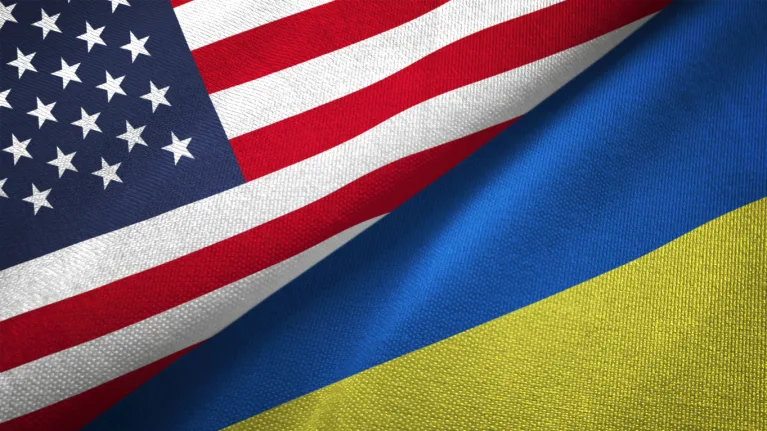The U.S. Role in Ukraine’s Success
It's much bigger than it appears.

In their report “Ukrainian Officials Drew on U.S. Intelligence to Plan Counteroffensive,” Julian E. Barnes and Helene Cooper of NYT detail the degree to which we’ve helped steer Kyiv’s success.
Senior Ukrainian officials stepped up intelligence sharing with their American counterparts over the summer as they began to plan the counteroffensive that allowed them to make dramatic gains in the northeast in recent days, a shift that allowed the United States to provide better and more relevant information about Russian weaknesses, according to American officials.
Throughout the war, the United States has provided Ukraine with information on command posts, ammunition depots and other key nodes in the Russian military lines. Such real-time intelligence has allowed the Ukrainians — who U.S. officials acknowledge have played the decisive role in planning and execution — to target Russian forces, kill senior generals and force ammunition supplies to be moved farther from the Russian front lines.
But earlier on, American intelligence officials said they often had a better understanding of Russia’s military plans than of Ukraine’s. Concerned that sharing their operational plans could highlight weaknesses and discourage continued American support, the Ukrainians were closely guarding their operational plans even as American intelligence was gathering precise details on what the Kremlin was ordering and Russian commanders were planning.
But as Ukraine laid its plans to strike back against the Russians, senior leaders in Kyiv decided that sharing more information with the United States would help secure more assistance, American officials said.
Senior U.S. officials declined to say how much details from the counteroffensive plan Ukraine had shared and how much advice the United States had offered. But one official said Americans had “constantly” discussed with Kyiv ways that Ukraine could blunt the Russian advance in the country’s east.
The gains in the northeast, including the recapture of Izium, a key railway hub, were the most important advances Ukraine has made so far, senior American officials said.
It is not yet clear how much broad strategic importance those gains will have, but there are signs that the current offensive could be the early stages of a drive that could push back the Russian front line significantly, military experts and former intelligence officials said.
As I’ve emphasized before, the Ukrainians themselves deserve all the credit for their success. They’ve risked everything and fought bravely. At the same time, it’s been obvious since the beginning that they’ve had world-class ISR (intelligence, surveillance, and reconnaissance) that they themselves couldn’t bring to the table.
While President Biden rightly drew the line at direct kinetic involvement by U.S. forces, he’s been pretty much all-in otherwise in a way that, to put it mildly, a President Trump most certainly wouldn’t have. I think he’s genuinely outraged by Putin’s transgressions of the norms of the past century-plus in invading a sovereign state with an intent of conquest.* At the same time, he’s absolutely taking advantage of the situation to fight a de facto proxy war against the regime our National Defense Strategy proclaims as our number two adversary.
It’s perfectly understandable that President Zelensky was simultaneously happy to take whatever help we would offer yet wary of sharing too much of his strategy with us, given our mixed motivations. Clearly, though, we’ve built enough trust that he’s willing to help us help him. Whatever our shortcomings, we’re pretty good at operational planning.
“I have thought for several months that Ukraine was going to push Russia back to the 23 February lines by the end of the year,” said retired Lt. Gen. Frederick B. Hodges, a former top U.S. Army commander in Europe, referring to the eve of the Russian invasion. “I watch the Russian logistics, and it just looked to me that they cannot sustain this. Their morale and discipline and all their manpower issues — it’s just not sustainable for them to do what they were trying to do.”
General Hodges said the recent success indicated that Ukraine’s efforts to retake land in the south and east could unfold more quickly than he had previously assessed, even setting the stage for an attempt to retake Crimea next year. Other experts agreed that the tide might be turning for Ukraine.
“The Ukrainian military’s counteroffensive is moving faster and taking terrain even faster than expected,” said Mick Mulroy, a former Pentagon official and C.I.A. officer. “Now is the time for the Ukrainian army to exploit every opportunity they have to degrade and destroy the Russian capacity to fight.”
These folks have a lot of experience but I have no idea how much insight they have into current operations. Let us hope they’re right.
Current and former U.S. officials praised the sophistication of the Ukrainian preparations for the counteroffensive. The decision by Ukraine to tout its counteroffensive in the south before striking in the northeast is a standard technique for misdirection used by the American Special Operations troops, who have been training the Ukrainians since the annexation of Crimea in 2014.
“These guys have been trained for eight years by Special Ops,” said Evelyn Farkas, the top Pentagon official for Ukraine and Russia in the Obama administration. “They’ve been taught about irregular warfare. They’ve been taught by our intelligence operators about deception and psychological operations.”
Even though messaging around the push in the south may have been something of a feint, officials say that strike also has importance. Even small gains in the south will make it far more difficult for Russian forces to capture the port city of Odesa, a wartime goal of President Vladimir V. Putin.
My strong surmise—based on zero inside information—is that, in addition to years of being trained by our folks, their current planning is being done in concert with U.S. and NATO planners.
Nevertheless, current U.S. officials were reserved on Saturday, saying it was too early to determine whether the Ukrainian military could keep up its drive.
The offensive will strain the Ukrainians, who have suffered from shortages in supply, particularly artillery rounds. Their army, too, has taken tough casualties. Going on the offensive is harder and more difficult to maintain than a defense. Some American officials believe the more successful Ukraine is in the next few days, the more Russia will look for ways to strike back.
But the new offensive has demonstrated how the Russian forces have not been able to overcome the fundamental problems laid bare in the opening days of the conflict, American officials said.
The Russian military continues to struggle to get its secure communications to work and to solve its logistics problems. It has also not been able to ramp up its industrial base to meet the demands of the war, multiple officials said. Ukrainian air defenses still threaten Russian aircraft, hampering Moscow from using the full potential of its military.
In addition to underestimating Ukrainian resolve, I think we’ve all been surprised by how far their capabilities have come since the 2014 putsch of Crimea. And, again, while I think the Ukrainians themselves deserve the credit, it’s also true that they’ve had a lot of help. Help that, thanks to the nature of bureaucratic inertia, continued even during the four years of a President willing to sell them out.
Further, as The Intercept‘s Alice Speri notes, this is not only a bigger investment than most Americans realize but a long-term one.
Because the assistance is drawn from a variety of sources — and because it’s not always easy to distinguish between aid that’s been authorized, pledged, or delivered — some analysts estimate the true figure of the U.S. commitment to Ukraine is much higher: up to $40 billion in security assistance, or $110 million a day over the last year.
[…]
Analysts estimate that Ukraine, already the largest recipient of U.S. security assistance in Europe since 2014, is well on track to become the largest recipient of U.S. security assistance of the century altogether. From World War II Britain to South Vietnam, to the more recent wars in Afghanistan and Iraq, the U.S. government has long conducted foreign policy by supporting, and in some cases building up from scratch, the military capabilities of its allies — often with mixed results.
[…]
There is little precedent for the breakneck pace and scale of U.S. spending on Ukraine. “It’s more than the peak it paid to Afghanistan by a long shot and many times more than aid to Israel,” William Hartung, director of the arms and security program at the Center for International Policy, told The Intercept. “And it’s somewhat unique that they’ve been arming a country where there are two nation states at war.”
The most recent U.S. military assistance announcements also marked a significant shift in the scope of the U.S. commitment to Ukraine. Earlier packages mostly involved the Defense Department drawing from preexisting stock to quickly equip Ukrainian forces in the face of urgent need — to the tune of $8.6 billion worth of equipment over the last year. The $675 million drawdown announced by Blinken this week marked the 20th time the administration invoked this authority to support Ukrainian defense. The $3 billion package announced by Biden last month, however, involves new contracts with defense manufacturers to produce equipment that will be delivered to Ukraine over months and years, in order to, according to officials, “build the enduring strength of their forces to ensure the continued freedom and independence of the Ukrainian people.”
In other words, as Under Secretary of Defense for Public Policy Colin Kahl put it, this aid is not intended to support Ukraine in “today’s fight” but “for years to come.”
Ukraine will almost certainly not become a member of NATO any time soon. But we’re very much treating it as though it were one.
_________________
*While there’s a strong argument that the 2003 U.S. invasion of Iraq was in violation of international law, it’s simply an entirely different animal than what’s going on here. First, Saddam Hussein was in long and repeated violation of multiple UN Security Council Resolutions. Second, we made it clear immediately after toppling Saddam’s regime that the Iraqi people were sovereign and went overboard to support a democratic Iraq and bolster its government. That we did it poorly and naively doesn’t change that fact.





Sorry for the OT, but I feel like there’s a “that’s what he said” joke in there somewhere …
The wisdom of the Jacob Riis quote applies here also:
Looking forward, yes, the Ukrainians have to be careful of running too far ahead of its logistics. Another fear, however, is what will happen in the recaptured Ukrainian territories WRT to Russian collaborators. I suspect there will be a real blood bath there.
What strikes me about this is that not only is the Russian military much less than advertised, but so is Russian intelligence. It’s ridiculous that a modern ‘superpower’ could fail to notice what was clearly a large buildup in the Kharkiv area. It’s practically on their border. Imagine that we are at war with Canada, and we somehow missed that they were massing troops for an attack on Spokane. Are their satellites as shit as their tanks?
I don’t know how Putin can spin this, even to his ill-informed, MAGA-equivalent population. Another glorious retreat! The Russian lines have collapsed on the Kharkiv front and in the south a big bunch of Russian troops are immobilized on the wrong side of the river with blown bridges to their backs.
This is Russia, for Christ’s sake, the Big Evil, the Darth Vader of geopolitics, the Sauron of the 20th and early 21st centuries, and this is what they’ve got?
Yes, the US is doing just about everything short of pulling triggers in this war.
But this settles a big unknown regarding Ukrainian capabilities – they were able to execute a combined-arms movement operation very effectively – something they have never demonstrated the ability to do. This could really change the course of this war, considering the Russians have not been able to adapt, have continuing manpower shortages that are going to get worse without mobilization, and have force structure problems that can’t be quickly fixed, even assuming the Russians are capable of fixing them in strategically relevant time-scales.
I think Michael is correct to point out the Russian intelligence failure here. Russia probably can’t fly drones and reconnaissance aircraft over Ukraine for ISR, but they do have significant SIGINT capabilities as well as satellites. But any intelligence function is vulnerable to deception, especially if your adversary understands your capabilities and limitations. Personally, I see the hand of the US here too, and we likely helped them with the deception, concealment, and OPSEC efforts.
But Russia’s force structure problems and lack of manpower continue to be the most significant factors in the weakness of Russian combat power and effectiveness. Interestingly, Putin has basically done everything he can to avoid mobilization and turning this into a formal war. This is still a “special military operation,” which comes with certain limitations. The current Russian forces are mostly spent. They do not have enough reserve units to rotate forces on the front lines. This makes those front-line forces much weaker on the defense and makes offensive operations about impossible. It’s hard to see, at this point, where the Russians go from here without some kind of mobilization, but even that doesn’t happen instantly as the ability to recruit and train personnel and organize them into units is measured in many months.
@Andy:
Even after mobilization the Russians would be throwing low-morale, barely-trained soldiers in against a very experienced, very well-equipped, very much US-supported and very high morale Ukrainians.
It’d be an interesting speech for Putin to give from his giant table in the Kremlin. “So. . . remember that special military operation that’d be over in a couple days? Well, funny thing. . .”
It took us a decade to fuck up this badly in Vietnam. This is a Cannae/Gallipoli/Market Garden level fuck up, just an amazing shitshow. I don’t think it’s outside the range of possibilities that large portions of the Russian army pulls a 1917, just turns around and starts to walk home.
@Scott:
I’ve seen this pop up a few times on twitter, from the pro-Russian twitterati.
War sucks. There are atrocities in every war on every side. It’s why we try to avoid war. Any crimes that occur are largely the fault of those who started the war. (There’s plenty of blame to go around, I’m not excusing those who perform the atrocities, but when you start a war you know that will happen)
If you set a fire with the intent of killing people over there, and then the wind shifts and it kills different people… that’s still your fault.
Meanwhile, I’d like to know where the Ukrainian men who were put on busses and shipped off to Russia ended up. And who ordered the killing of military age Ukrainian men in the town outside of Kyiv before the Russians pulled back (I’d look up the details, but I don’t need to see photos of dead people in streets on my Sunday). And the shelling of civilians.
I’m not going to let a few atrocities likely to be committed by the Ukrainian forces shake me to the core, when war is just a collection of atrocities.
In an ideal world, the Ukrainian army would have the discipline to ensure that there is no retribution for things like that. But that ideal world doesn’t have people in it, it has something else.
If this war is like any other war in human history, the collaborators should run like hell.
@Andy:
Yes but as the size of the area they need to defend shrinks it becomes easier for them. It appears to me they stripped nearly all of their artillery from the Kharkiv front for use elsewhere and were planning to run like hell if their gossamer armor there was exposed. The Ukrainians are reporting extremely light casualties, they seem to be mostly invading abandoned towns.
Unless there is a collapse in general morale there’s a ways to go yet.
@Gustopher:
They blamed Abu Ghraib on some enlisted personnel and IIRC retired a Brigadier. It was George. W. Bush’s fault. As were all the hundreds of thousands of Iraqi deaths that flowed from our invasion.
More expensive than supporting the Ukraine military will be the cost of rebuilding. I hope Europe is ready to help if Ukraine manages to maintain its territory.
Certainly Russia, if it were to win, wouldn’t have many spare resources for rebuilding there. A ‘win’ may more likely bankrupt Russia than a loss at this point.
@Argon: Serious question: When did the Soviets rebuild anything either they or someone else blew to smithereens anywhere not named “Russia?” Why does anyone suppose Putin will act differently?